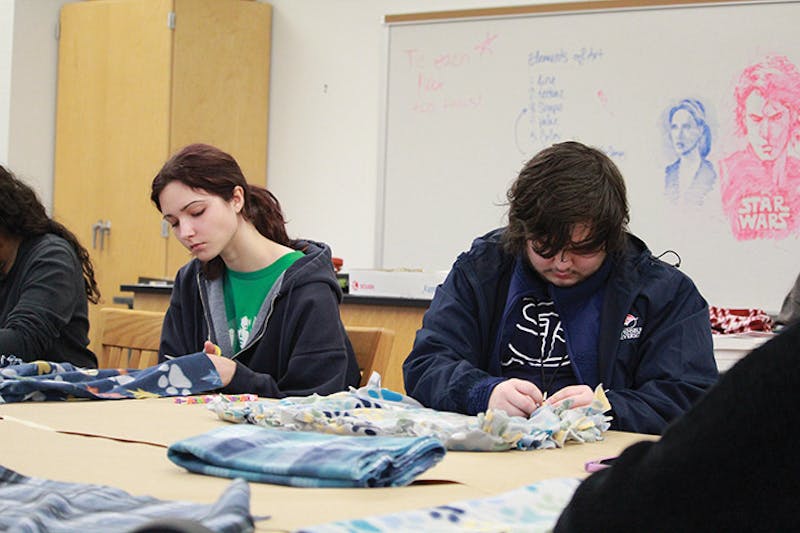Here’s a point of view: Your alarm goes off. You walk to the closet after a long night of sleep, and you find a pair of jeans that you just bought and have been so excited to wear. You put together an outfit and you’re running late, so you grab your backpack and try to slide your phone into the back pocket of your jeans – until you realize there isn’t one, and your phone falls to the floor.
Clothing functionality has been an issue for hundreds of years. For example, in the 17th century, women’s clothing functionality was anything but convenient – bodices, pleated sleeves and crinolines created a world of disruption.
In older times, there was no chance of convenience based on knowledge of those designated items. The 21st century has made fashion much more convenient with items such as sweatpants, sweatshirts and leggings, however there has been an overall decline in the functionality of those “simple” items.
On college campuses, the previously mentioned pieces – sweatpants, sweatshirts and leggings – are worn frequently due to ease and comfort. Nevertheless, because they are comfortable and easy does not make them convenient.
On a recurring basis, sweatshirts, oftentimes , do not have pockets or hoods – which most people enjoy. Crewnecks are extremely popular in 2023, but because of that, crewnecks should be evolving with the rest of fashion: internal built-in pockets with zippers. Lack of pockets is a huge issue.
Likewise, sweatshirts with hoods, or “hoodies,” have not evolved with fashion either. Hoodies should have a pocket on the front or the side with zippers. This is functional and allows for items to be easily located.
Similarly, sweatpants encompass the same form of issue. Sweatpants come in a variety of styles: flared, straight legged, cuffed and jogger. Flared sweatpants have become the most popular on campuses, but there are still a plentiful amount of other styles that are worn. All of the styles are composed of functionality problems – once again including pockets. Pockets should always have a zipper to ensure nothing falls out. Pockets are made of thin material that can be easily ripped, which is another commonality in clothing.
Other disadvantages for functionality are waistbands and drawstrings; waistbands don’t fit or they stretch – lacking in elastane to keep them sturdy, and drawstrings don’t come on all pairs of sweatpants. Lots of people like their sweats to be breathable and loose, which leads to a looser waist. Because drawstrings aren’t guaranteed on all pairs of sweatpants, it can become difficult for people to feel fully comfortable and confident in their clothing.
College students move around constantly. Moving around constantly leads to a larger issue of being seen by many people, which means that students want to feel confident in what they’re wearing.
Due to this, leggings are a very hot commodity. Leggings are stretchy, breathable and flattering; however, there are functionality issues within the clothing. Back to the most important problem: there are no pockets. Some leggings, mostly athletic, offer pockets to those who wear them, so that people can carry their phones, keys, wallets and other items while they’re being active.
There is an issue at hand, and that is that they are extremely expensive. Leggings also do not have a consistency in length, as they mostly lose their fit. Lastly, leggings are made from different materials such as polyester, elastane and cotton; most of the time, they become loose, unflattering, and easily able to fall or “sag.” This is a functionality issue.
Back to the opening statement, jeans are popular in college for moments including speeches, meetings, business arrangements and confidence. Jeans are among the worst of functionality problems.
Jeans are denim, but all denim is made differently. Jeans are unreliable in recent times because they are either too dense, stiff, loose, soft or incompatible. Many people have relied on “fast fashion”, which are online shops who produce clothing for small amounts of money based on the inappropriate pay they offer their staff. Due to fast fashion, the clothing is not made out of dependable materials; this leads to short usage and unsatisfactory performance.
Jeans fit in different areas of the body. Different styles of jeans fit incorrectly depending on brand and style. There is a lack of understanding for size options, making it difficult to order online because the same size never fits the same. There are often holes in inconvenient areas, like pockets, that lead to items falling out. There are no pockets in some of the styles, and they lose their shape because of wear-and-tear.
Lots of clothing pieces offer good features to people who purchase them, but they also offer tons of functionality issues. There are easy solutions; they must be publicly discussed for a change, but publicly discussing changes is a dysfunctionality within itself.



The Slate welcomes thoughtful discussion on all of our stories, but please keep comments civil and on-topic. Read our full guidelines here.